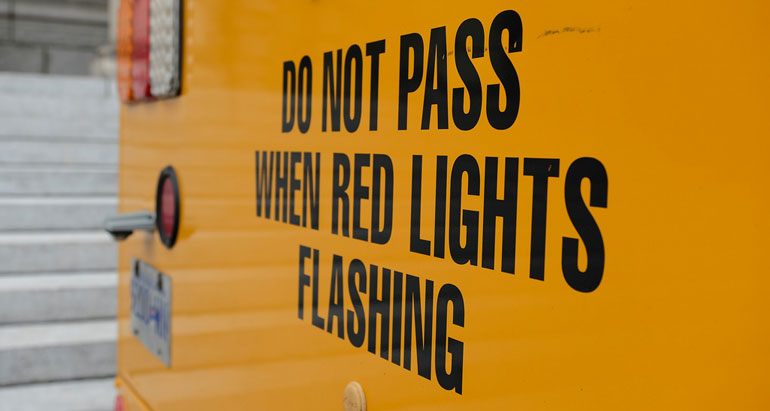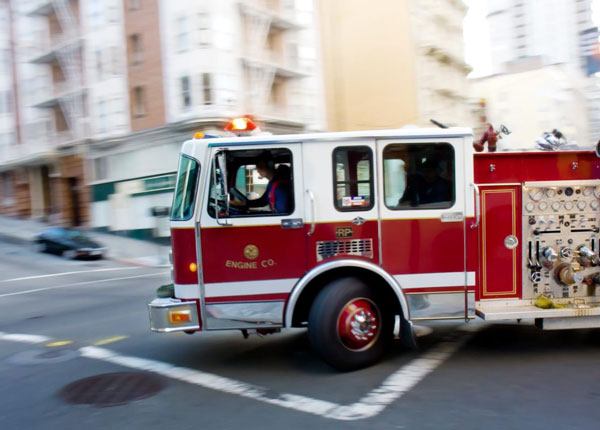
Sharing the Road with Buses: When to Stop, Warning Lights, Passing a School Bus
Updated Dec. 11, 2020The precise definition of a bus varies a little from state to state, though it is safe to assume that any vehicle used for passenger transportation that is designed to carry more than ten people qualifies. We will discuss the challenges you face when sharing the road with ordinary passenger buses and school buses.
Buses are large, difficult to handle and their operators must cope with limited visibility. These are issues that all road users must consider – not just the bus drivers themselves. To share the road with buses safely, you should take into account their limitations and adjust your own driving accordingly. Motorists should also keep in mind that buses will stop frequently to load and unload passengers. Watch out for this happening and make sure you yield the right-of-way wherever possible.
Stopping for school buses
Stopping for school buses is not just advisable, it is a legal requirement. These buses can usually be identified by their “SCHOOL BUS” sign, yellow-orange coloring and flashing red warning lights which the driver will activate when the vehicle has stopped. Great care must always be exercised in the vicinity of a stopped school bus, as there are likely to be children around who are not paying attention to the road.
If you are approaching a stopped school bus from either direction on a two-way street or highway, you must stop at least 20ft away from the vehicle. However, if the highway is split by a raised barrier or unpaved median of at least five feet wide, drivers traveling in the opposite direction to the bus need not stop and may proceed with caution.
Yellow or amber lights
School buses usually have overhead yellow or amber lights that will flash alternately, both in front and in the rear. These lights should be activated roughly ten seconds prior to the school bus stopping, at which point the red overhead stop lights will take their place.
Approach a bus with flashing yellow or amber lights with caution, while preparing yourself to stop. Children may be playing by the roadside or running to board the bus.
Red lights
School buses that have stopped to unload or pick up children should have a flashing red overhead light. Failing to stop for a school bus with a flashing red warning light or stop arm is a serious offense for which fines and a custodial sentence may be awarded.
Having stopped for a school bus you must not proceed until the red light has stopped flashing, the school bus has started to move off or the driver indicates that you may pass. Even then, you should proceed with extreme care.
Of the injuries and fatalities that occur around school buses, most happen because a child has unexpectedly darted out into the road from behind a stopped vehicle.
 When the RED overhead lights are flashing, stop at least 20 feet from the school bus. Remain stopped until the flashing red lights are turned off or the bus resumes its travels.
When the RED overhead lights are flashing, stop at least 20 feet from the school bus. Remain stopped until the flashing red lights are turned off or the bus resumes its travels.Passing a stopped school bus
In most states, the penalties for passing a stopped school bus are severe. It will be assumed that the registered owner of any vehicle is the driver, unless it is otherwise apparent that somebody else is behind the wheel. A few examples of state-specific penalties are listed below:
New York: The fine for passing a stopped school bus ranges from $400 for a first violation, to a maximum of $1500 for three violations in three years. A third conviction within this time will also result in you losing your license for a minimum of six months.
Texas: A fine of $500 - $1,250 for the first conviction and for every subsequent conviction within a five-year period, a fine of $1000 to $2000. If you are convicted of multiple offenses and have caused serious bodily harm to a person when passing a stopped school bus, you could be fined up to $10,000 and receive up to two years in jail.
Georgia: Passing a stopped school bus is considered a Class A misdemeanor, punishable with a fine of $250 o $1,000, up to 90 days in jail, or both. Causing death as a result of failing to stop for a school bus will be treated as a felony.
As you can see, the fines and penalties for passing a stopped school bus are different state-by-state. Information relevant to your area can be found in your state’s own driving manual.
School bus danger zones
Due to their length and height, school buses have “danger zones” that cannot easily be seen from the driver’s seat. These include the space immediately behind the vehicle and each side, near the rear wheels. Occupying these spaces is dangerous, even up to 10ft away from the school bus. Avoid school bus danger zones while the vehicle is in motion, to minimize the risk of a collision.
School buses and railroad crossings
School buses are required by law to stop at every railroad crossing, regardless of whether a train appears to be approaching. You must be prepared to slow down and stop when following a school bus over a railway crossing. Do not sound your horn or attempt to pass a stopped school bus at a crossing.
Regular buses, trams and trolleys
The distance at which you follow a school bus, regular bus, tram or trolley must be greater than it would be for an ordinary car. This will give you a better view of the road ahead, including curbside passenger stops where a bus is likely to pull in. Following at a greater distance will also keep you safely out of the way of the vehicle’s rear blind spot.
Depending on where you are from in the United States, trolleys, trams and other old-fashioned passenger vehicles can be a distraction. In some states, they are still used frequently, while in others they are rarely seen. Try to remain focused on all road hazards when driving in the presence of these vehicles. Always stop when a trolley pulls in ahead of you to unload or pick up passengers, and never follow these vehicles too closely.
 Always be aware of light rail vehicle routes. Keep a safe distance from light rail vehicles when they share the road with other traffic.
Always be aware of light rail vehicle routes. Keep a safe distance from light rail vehicles when they share the road with other traffic.



